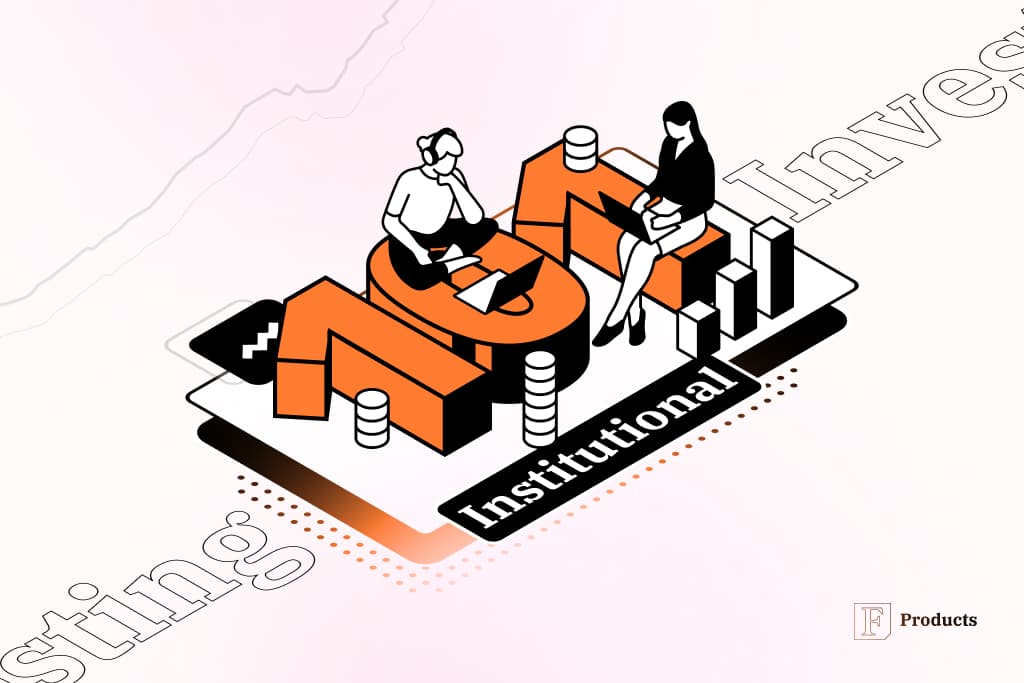In theory, the stock market is a level playing field where everyone is equal and participates without any inherent advantages or disadvantages. In practice, however, the vast majority of transactions are done by institutional investors, as “whales of Wall Street” dominate and reshape the financial environment with their actions. This guide will dive into institutional investing, explain how to track it, and, ultimately, how to leverage it to your advantage.
What is institutional investing?
You can feel droplets of sweat cooling on your forehead. What was a short-selling golden goose yesterday has become a searing fireball tearing through your accounts. How did a group of foolish, incapable amateurs on a random forum even manage to push the price of the stock over 15 times? The guy you spoke with a minute ago convinced you they’d kill the platforms, thank God. But the damage is massive. And someone will have to take the fall. Hopefully, not me.
Something similar happened in early 2021 when Redditors from r/WallStreetBets found and exploited stocks heavily shorted by institutions. Their efforts created a short squeeze that caused severe losses to Wall Street whales, limited only by the controversial restriction of trading platforms like Robinhood. The event was marked by lawsuits and investigations that highlighted the insurmountable differences between the big players and individual investors.
But we’re rushing ahead of ourselves. Let’s go back to the beginning.
“When people ask me what I do for a living, I generally tell them ‘I run a hedge fund.’ The majority give me a strange look, so I quickly add, ‘I am a money manager.’ When the strange look persists, as it often does, I correct it to simply, ‘I’m an investor.’ Everyone knows what that is.”
— David Einhorn, the founder and president of Greenlight Capital
What is an institutional investor?
In other words, institutional investing is done by organizations such as hedge funds, mutual funds and ETFs, insurance companies, pensions, and investment banks. By contrast, retail investors are individuals who invest their own money.
The differences between institutional vs retail investors
To begin with, institutional investors have much more funds at their disposal than retail investors. They trade in much larger volumes, often buying stock in bulk, a hundred or thousand times more than the average number of shares a retail investor would trade. Due to sheer scale, their transactions significantly influence the rest of the market.
In fact, Morgan Stanley stated in 2019 that institutional investors account for 90% of the U.S. stock trading volume. Additionally, according to research by Boston Consulting Group, the global assets under management amounted to $98 trillion in 2023.
As organizations specializing in investing, institutional investors have resources and knowledge about the market that remain unavailable to retail investors. They tend to employ highly skilled and experienced financial experts and analytical tools that are commonly out of reach to regular individuals.
Furthermore, they gain privileged access to specific stocks, and certain financial authorities (like the U.S. Securities and Exchange Commission or SEC) have less restrictive regulations on institutional investing.
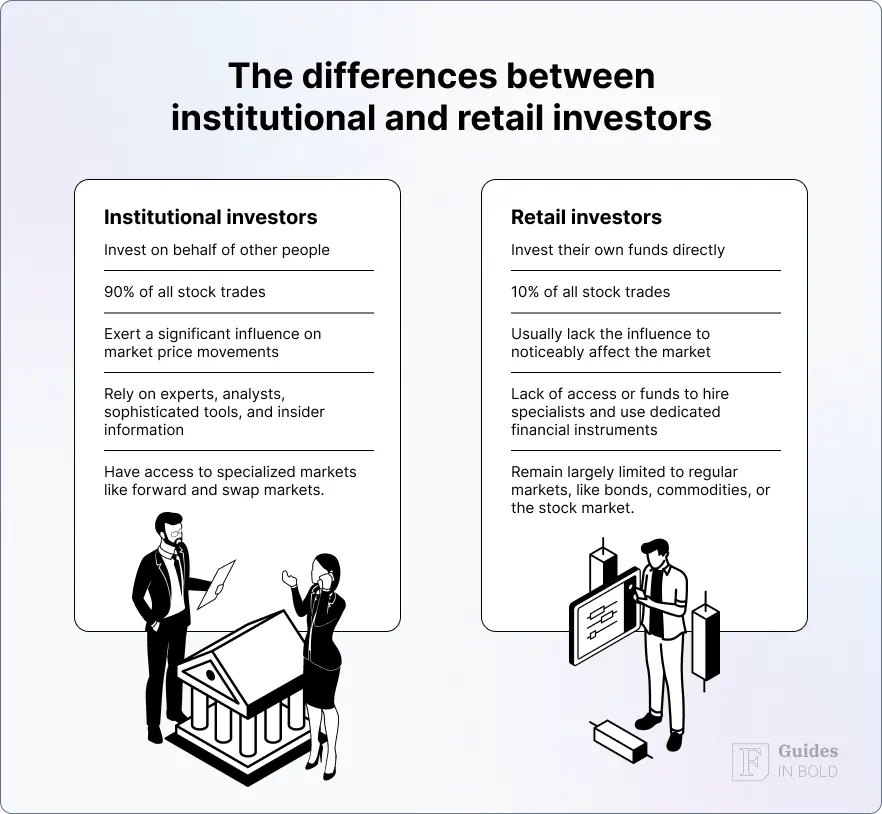
Considering everything, it is safe to assume that institutional investors are much more sophisticated and influential on a global scale than retail investors.
How does institutional investing work?
Well, like we said, institutional investors buy and sell financial assets on behalf of their clients. However, institutional investing is different from regular retail investing in several aspects.
The first and most obvious difference is the scale of trading. When a retail investor buys 50 shares, institutional investors buy 500 to 5,000 shares. Hedge funds and similar organizations trade in large blocks that are never subtle: if an institutional investor goes in, the stock’s value will jump; if they move out, the price will likely take a nosedive.
Next, due to their expertise and the size of available funds, financial authorities sometimes apply more relaxed regulations to institutional investors and provide them with access to out-of-bounds equity (like pre-IPO investing) and markets. Conversely, security laws typically restrict certain institutional investors that classify as diversified funds from acquiring a high percentage of vote-carrying securities.
Finally, institutional investing is usually enhanced by specialized instruments and experts, meaning it commonly conducts professional research, employs economists and seasoned traders, and relies on portfolio managers to manage its assets. Due to the nature of their work, some organizations may also have privileged access to confidential insider information that could help them guide their decisions.
Institutional investing and insider trading
The relationship between institutional investing and insider trading is complex and difficult to determine, especially since illegal insider trading is not always easy to spot. After all, did their decision to buy or sell come from extensive research or an informed tip?
What is insider trading?

A 2023 study shows that hedge funds base their decisions on opportunistic insider trades and that their ability to exploit insider information enhances their financial performance. On the other hand, the study concludes that other institutional investors, like pension funds, mutual funds, and banks, tend to go in the opposite direction or contrary to insider trades.
That said, once an institutional investor establishes a position in the company, the logic conveys that it would reduce the spread of insider information, which goes against its public interests.
However, it could promote insider trading to incentivize executives and, therefore, the company’s productivity. A 2015 analysis has shown that institutional ownership is negatively related to insider sales, owing to direct monitoring, while it has a positive relationship with the profitability of insider purchases, affirming its incentivizing role.
Still, the question remains: do institutional investors trade based on confidential material knowledge? Yes, they do.
Recommended video: What is Insider Trading? Explained in 2 Minutes
How do institutional investors obtain insider information?
Insightful academic research in 2023 observes the belligerent relationship between institutional and insider traders: the rivalry over who is the first to act on private information.
The study has shown that insiders trade faster when institutions like hedge funds are likely to learn of insider information and compete, reducing their profits.
Additionally, the study examines how institutional investors obtain confidential insider information. It discovers two primary factors: a shared broker and geographical proximity, e.g., having headquarters in the same city.
Ultimately, we can derive one solid conclusion from all this. Although insider traders and institutional investors have a rival relationship, both are prone to using insider information, arguably at the expense of the investing public.
“Smart money”
The concept of smart money refers to the behavior, flow, supply, and demand of the vast funds at the disposal of institutional investors. Since their capital dwarfs the funds used by retail investors, institutional traders inevitably leave a footprint on the market chart whenever they trade. Following the smart money aims to identify where and when the whales of Wall Street trade and benefit from the ensuing effects on the market.
When investors check for institutional market movements they refer to the concept of smart money, which includes:
- Buying and selling times: In addition to the conventional market movement, smart money introduces periods of high demand and high selling pressure, which potentially reveals ideal points when to buy and sell;
- Order flow trading: Adding to the market price movements, smart money introduces institutional transactions, such as selling in an uptrend or buying in a downtrend. The big players conduct these when anticipating the potential reversal in the price movement trend, which can then be noticed by retail investors and acted upon;
- Institutional influence on the market: Smart money also recognizes that institutional effects can be analyzed separately from the rest of market activity. Therefore, it puts market analysis in the context of institutional activity, thus helping traders figure out which signs are false flags and which indicate institutional investing involvement.
How do institutional investors make money?
If institutional investors manage other people’s funds, how do they make money?
Well, most institutional investors earn an income by charging each client or member specific fees and commissions. They usually claim a fixed percentage of a client’s gains. In addition to a cut from the profits, an institutional investor might have a flat fee for account management, making trades, or money withdrawals.
For example, hedge funds take between 1% or 2% of total investment value and about 20% on average of any profits that go to the hedge fund manager. Insurance companies charge premiums for their services and reinvest them across a diverse portfolio of low-risk assets that generate interest, such as bonds.
An obvious exception is foundations, which are charities formed to fund other charities. Their funds come via endowments or donations from companies and wealthy individuals, which are then invested, usually into low-risk financial assets for long-term gains.
Types of institutional investors
Since we’ve already started mentioning some of them, let’s classify and define the most common types of institutional investors. These include:
- Mutual funds;
- Hedge funds;
- Pension funds;
- Exchange-traded funds (ETFs);
- Insurance companies;
- Foundations.
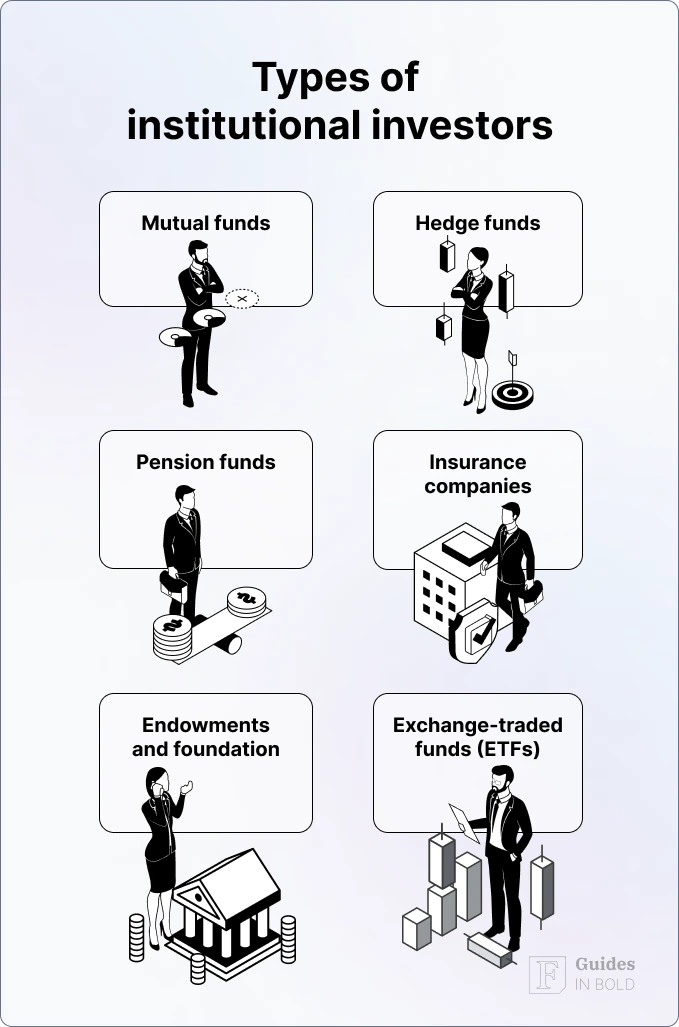
Mutual funds
The most common type of institutional investor, mutual funds represent pooled funds from various individuals and organizations that are used to buy securities, usually equity, real estate, and private debt. They are run by expert portfolio managers and represent a common way for people to invest their disposable money without having to master investing.
Mutual funds are versatile and generally operate within different industries and assets. They usually limit risk and keep a reserve of liquid assets in case clients request to retract their positions.
Hedge funds
In essence, hedge funds are similar to mutual funds. They also allow people to combine their resources and invest in securities. However, the main difference is that hedge funds are more difficult to get into and aim for higher risk and higher returns than mutual funds.
Aggressive investment policies and membership exclusivity characterize this type of institutional investor.
Pension funds
Another popular form of institutional investing, pension funds manage working people’s savings and can be either government-run or private. Once pension funds’ clients retire, they become beneficiaries of the fund and draw a monthly pension from the pooled funds.
Pension funds also invest in a diverse range of assets but remain more constricted by their liquidity and risk standards. In the United States, the rules for pension funds are set out by the Employee Retirement Income Security Act (ERISA). That said, they can still invest a minor portion of their assets in exclusive markets, like private equity and mutual or hedge funds.
Exchange-traded funds
Similar to mutual funds and hedge funds, exchange-traded funds (ETFs) pool funds from various individual and institutional investors and purchase a diversified portfolio of securities, most commonly stocks. Experts also manage these funds, but they usually aim to replicate the performance of a specific industry or sector.
High liquidity, a diverse portfolio, and low associated investment and management fees make ETFs attractive to retail investors and other institutional investors alike. ETFs are very transparent, flexible, and cost-effective. Furthermore, they can be traded on exchanges just like regular stocks.
Some of the largest and most popular ETFs include SPDR S&P 500 ETF Trust (SPY), iShares Core S&P 500 ETF (IVV), and Vanguard Total Stock Market ETF (VTI).
Insurance companies
Insurance companies also pool funds in the form of premiums in order to protect clients from various risks and meet potential future liabilities. These premiums, however, do not sit idle but are invested by the companies to earn a profit and provide for future claims.
These institutional investors invest primarily in long-term, low-risk assets such as bonds, fixed-income, real estate, and sometimes even stock, depending on the type of risk that the insurance company covers.
Endowments and foundations
Endowments and foundations are a special type of institutional investor associated with humanitarian and altruistic goals, such as charities, hospitals, universities, and non-profit organizations. Most of them aim to increase the quality of life through public service, education, and healthcare.
Endowments are usually founded through wills and dedicated estates and tend to keep their principal intact, using only the profits made from their usually long-term investments. Foundations, on the other hand, accept donations and organize fund-raising events to raise funds. Both have limited investing capacities that they usually put into long-term, low-risk assets.
Largest institutional investors
If most of the world’s securities trading comes from institutional investors, can you imagine how huge the largest of them are? Here are the five largest institutional investors by assets under management (AuM):
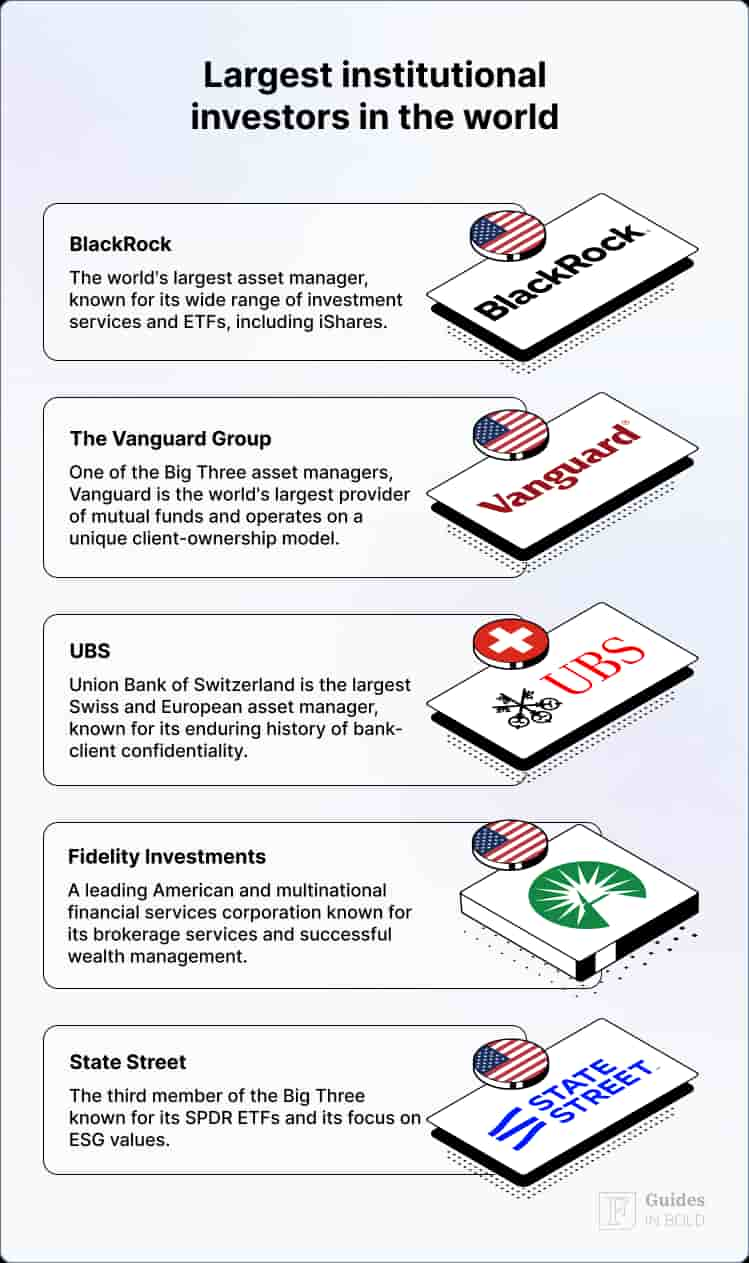
1. BlackRock
The biggest player among the Wall Street whales is BlackRock, an American investment company and the world’s largest institutional investor with a whopping $10.65 trillion (as of October 2024) in AuM.
Founded in 1988 by Larry Fink and a group of partners to focus on risk management and fixed income, BlackRock has evolved to include most types of securities, from equities and real estate to alternative investments and future technologies. A key component of its success is Aladdin, the company’s risk management platform, which many financial institutions frequently rely on.
BlackRock’s ETFs, known under the iShares brand, are among the most successful in the market. Furthermore, BlackRock is the most prominent advocate for environmental, social, and governance (ESG) investing.
2. The Vanguard Group
The close second behind BlackRock with $9.9 trillion (as of August 31, 2024) in global AuM is Vanguard, an investment management company and the world’s largest provider of mutual funds. Headquartered in Malvern, Pennsylvania, it is a part of the Big Three index fund managers and a crucial player in the American corporate landscape.
What makes Vanguard unique is that it works on a client-ownership basis, meaning that the company is owned by its customers and the funds they put into it. In fact, Vanguard’s founder, John C. Bogle, is credited with creating the first publicly available index fund.
3. UBS
The third on the list is the Union Bank of Switzerland, or UBS, with $5.87 trillion (as of April 2024) in global AuM. Founded in 1862, it is the largest European-based wealth manager and investment bank catering to high-net-worth individuals, groups, and institutions.
The bank is known for its international reach and reputation as one of the world’s busiest financial hubs. Additionally, it is known for its firm bank-client confidentiality and secrecy, which sometimes receives criticism.
4. Fidelity Investments
Fidelity Investments is another leading American and multinational financial services corporation with a long tradition of successful business in investment management, brokerage services, mutual funds, and wealth management. As of June 2024, the company has $5.5 trillion in AuM, making it the fourth-largest institutional investor in the world.
5. State Street
State Street, or State Street Global Advisors, to be precise, is the last member of the Big Three in institutional investing, with $4.4 trillion in AuM (as of June 2024). It has made a reputation for its “spider” (SPDR) ETFs, which notably includes SPDR S&P 500 ETF Trust (SPY), one of the largest and most popular ETFs in the world.
Besides SPY, this investment management subsidiary offers various other securities, including indices and equity. It is also notable for including ESG values when managing its portfolio.
Notable: Government Pension Investment Fund (Japan)
The world’s largest pension fund, with $1.59 trillion in AuM, is the Government Pension Investment Fund (GPIF), Japan’s incorporated administrative agency and the country’s largest public fund investor. For comparison, the largest pension fund in the United States is the Federal Retirement Thrift, with $0.78 trillion in AuM.
Notable: Bill & Melinda Gates Foundation
Probably the most recognizable foundation in the world, the Bill & Melinda Gates Foundation has over $69 billion in assets, making it the second-largest foundation by endowment value after Novo Nordisk Foundation. Like the name suggests, it was founded by Bill Gates and his ex-wife Melinda.
The foundation aims to improve global healthcare, reduce poverty, and increase access to education and information technologies. It has previously been active in developing countries, combating infectious diseases and boosting agricultural productivity. Furthermore, it has made efforts to promote philanthropic values and draw attention to numerous issues in today’s society.
What can institutional investing tell you?
Most institutional investors registered as companies in the United States have to regularly file quarterly reports with the U.S. Securities and Exchange Commission (SEC), which allows the public to peer into the mechanics of institutional investing. So, can retail investors derive any lessons from institutional investing?
The broad picture of institutional investing
Many investors see market fluctuations as their opportunity to profit, eagerly anticipating quarterly reports for a stock price reshuffle. For institutional investors, however, these are minor changes and ultimately negligible in the long run. After all, the time spans of their investments are decidedly long-term and measured in years, sometimes even decades.
Being patient allows them to look at the broad picture and invest with growth potential in mind rather than immediate profits. In turn, their portfolios tend to be more stable and sustainable. This does not mean that there are no institutional day traders–it just means that even frequent position changes usually stem from a fundamental, long-term factor.
Informed decisions
Although no investment result is guaranteed, managing risk is critical for successful investing. Institutional investors know this best, so they use a plethora of resources to get as close to the correct prediction as possible.
In other words, successful investment companies rely on exhaustive data sets, teams of financial experts, and breakthrough analytics software and tools to collect and decipher fiscal reports, quarterly results, and market sentiment. The ensuing conclusions allow them to predict market shifts and conduct decision-based trades on potential opportunities before the investing public.
Balancing risk
Institutional investing puts in great effort to manage risk and optimize portfolios to the benefit of their clients. Therefore, most institutional investors have diverse portfolios spanning several sectors, different types of assets, and both high- and low-risk securities.
Risk and reward are in direct proportion, meaning higher risk comes with higher potential rewards. Institutional investors, therefore, conduct comprehensive analyses of their portfolios to reach a comfortable value-risk ratio, diversifying to mitigate losses in one industry with gains in another.
What strategies do institutional traders use?
Many institutional investors and even fund managers use multiple investing strategies and approaches within an individual organization. In this guide, we will look at some of the most common (and successful) that you can use yourself.
Fundamental analysis
As one of the pillars of successful investing, fundamental analysis is the baseline of every long-term investment strategy employed by financial institutions.
What is fundamental analysis?
With this approach, institutional investors delve into the nitty-gritty of the company by looking at the following factors:
- Financial reports: Analyzing various statements like income, cash flow, and balance sheets to determine how profitable and solvent the company is, in addition to the liquidity of its assets;
- Leadership and management: Fundamental analysis also involves determining the company executives’ track record, capabilities, and motivation. Similar to how the quality of a flight depends on the plane crew’s skills, a company’s performance hinges on its management;
- Position in the market: Recognizing inherent strengths and potential weak spots and contrasting the results with the current market landscape can help investors identify a company’s potential and future trajectory.
Fundamental analysis allows investors to determine a company’s or asset’s actual value, as opposed to its current market price. The process can uncover undervalued gems with solid long-term growth potential and is integral to value investing strategies. Retail investors also use fundamental analysis, but it necessitates substantial time and expertise, making it primarily suitable for long-term trading.
Technical analysis
Unlike fundamental analysis, which disregards the company’s stock market price, technical analysis involves analyzing historical price and volume to spot patterns and use them to predict market movements. In other words, this method observes company performance strictly from the market valuation perspective, assuming that the market value is the actual value.
This approach further asserts that market prices follow a specific trend or pattern and that historical performance repeats in particular cycles. To identify and analyze these trends, institutional investors rely on:
- Technical analysis patterns: Sophisticated analytical tools aim to reveal recurring “reversal” patterns, like head and shoulders, death cross, and golden cross, and “continuation” patterns, like triangles, rectangles, and flags. Successfully identifying a pattern allows investors to forecast future price movements;
- Technical indicators: Similarly, mathematical calculations with formulas involving indicators such as moving averages, relative strength index, and pivot points can help measure the market momentum and conclude whether the price is going to rise or fall.
Focusing on market value, historical performance, and time-sensitive chronological patterns, technical analysis is primarily used in short-term trading strategies. Furthermore, this approach highlights the best entry and exit points for large positions, which is especially useful for institutional investors who tend to trade securities in bulk.
Mass-trading models and strategies
Institutional investing is done on a scale that retail investing simply cannot replicate. Market behemoths can then utilize advanced mathematics, machine learning, and automation to further benefit from the volume and frequency of their trades. Such methods include:
- High-frequency transactions: Market self-regulation is not instantaneous, and some institutional traders employ hyper-speed algorithms to benefit from fractional discrepancies in price that last only a fraction of a second;
- Mass-arbitrage: With specialized large-scale operational tools, the big investors are capable of noticing and capitalizing on differences across various asset classes, exchanges, and markets;
- Artificial intelligence and trading algorithms: Feeding an incredible number of historical market data to advanced neural networks allows institutional investors to train next-gen algorithms to predict market movements more precisely.
Mass-trading models and strategies exhibit record levels of speed and accuracy, giving institutional investors an edge over the rest of the market. By applying industrial-level AI, these investors can react to market events in near real-time.
Such strategies remain firmly out of the hands of retail investors. That said, there is an ongoing debate about the ethical concerns and institutional market manipulation introduced by algorithm trading. Still, retail investors could only benefit from mass-trading methods by tracking and copying institutional investing.
Where do institutional investors invest?
Institutional investors are not exactly limited in where they can invest. They regularly participate in the equity market, as well as real estate, private debt, commodities, and virtually every other market, including some that are virtually restricted to institutional investors, such as swaps and forward markets.
That said, the highest percentage of their portfolio remains invested in the stock market.
However, market forces impose some restrictions on institutional investors in this domain. In fact, big players do not invest in companies with small market capitalizations.
This is due to two reasons:
- Due to the high volume and intensity of institutional investing, buying or selling a small stock in bulk could create sharp imbalances in supply and demand, driving the price very high or very low.
- Some institutional investors, such as mutual funds and ETFs, are prohibited by law from obtaining a high percentage of ownership in the company, especially if the shares come with shareholder voting power. In general, acquiring more than 10% of voting power in a company is not allowed for most institutional investors.
Accredited investors
In addition to the institutionally oriented markets, such as swaps and futures, there are instances and assets in which only accredited investors are allowed to gain a position.
Who are accredited investors?
It should be noted here that an accredited investor is not the same as an institutional investor. An accredited investor is any person or organization registered with the SEC that satisfies at least one of the requirements, including sufficient net worth, annual income, governance status, and professional experience.
In the eyes of financial regulatory bodies, accredited investors have reduced needs for financial protection and, therefore, have exclusive access to pre-IPO companies, hedge funds, venture capital, angel investments, and various other instruments with more risks than conventional securities.
According to the SEC’s Rule 501 of Regulation D, which is the relevant legislation, anyone (not only institutional investors, but they as well) can become an accredited investor by fulfilling at least one of the following requirements:
- Two or more years of an annual income of over $200,000 ($300,000 if it is a joint spousal income);
- A net worth of over $1 million, excluding primary residence;
- The investor is a general partner, executive officer, or director of a company issuing unregistered securities;
- The investor is a private business development company or an organization worth over $5 million;
- If accredited investors own an entity, it is itself an accredited investor;
- The investor has sufficient education or experience working in the financial industry.
Dark pools
Despite their wicked and ominous-sounding name, dark pools are not a horror movie concept.
What are dark pools?
Used primarily by hedge funds and mutual funds, they offer reduced transaction costs and market impact. However, they are also marked by a lack of transparency, potential conflicts of interest, and predatory trading practices like front-running.
If an institutional investor wants to sell, for example, 100,000 shares of a company, the conventional exchanges allow several ways of achieving this:
- Work the order within a day or two;
- Split the order into several parts and sell one part per day;
- Sell individual shares until a buyer who is willing to buy the bulk at the desired price appears.
All three options have significant drawbacks regarding stock price, realization time, and market effects. However, dark pools’ lack of transparency allows the institutional investor to get a better price without adverse market effects, especially considering buyers and sellers trade in bulk.
However, there is always a risk of information leakage and high-frequency traders front-running once they catch wind of the pending trade.
That said, regulatory authorities like the SEC do monitor these platforms within the given framework, but they are still much less safe than the conventional (or “lit”) stock exchanges.
What are the top stocks for institutional investing?
So, what are the largest positions of the world’s most successful institutional investors? Let’s take a look at the top five stocks by percentage of portfolio:
BlackRock:
- Microsoft (MSFT) – 5.6% or 553.98 million shares;
- Nvidia (NVDA) – 5.14% or 1,839.27 million shares;
- Apple (AAPL) – 5.01% or 1,050.22 million shares;
- Amazon (AMZN) – 2.84% or 648.70 million shares;
- Meta Platforms (META) – 1.84% or 157.85 million shares.
Vanguard Group:
- Microsoft (MSFT) – 5.8% or 675.91 million shares;
- Apple (AAPL) – 5.36% or 1,324.97 million shares;
- Nvidia (NVDA) – 5.09% or 2,144.78 million shares;
- Amazon (AMZN) – 2.85% or 771.05 million shares;
- Meta Platforms (META) – 1.83% or 186.35 million shares.
Fidelity Management & Research
- Nvidia (NVDA) – 8.25% or 1,043.90 million shares;
- Microsoft (MSFT) – 6.2% or 216.69 million shares;
- Apple (AAPL) – 4.66% or 345.64 million shares;
- Meta Platforms (META) – 4.47% or 138.46 million shares;
- Amazon (AMZN) – 4.07% or 329.31 million shares.
As of 2024, based on the top stock holdings, the largest institutional investors’ favorite companies are Amazon, Apple, Meta, Microsoft, and Nvidia.
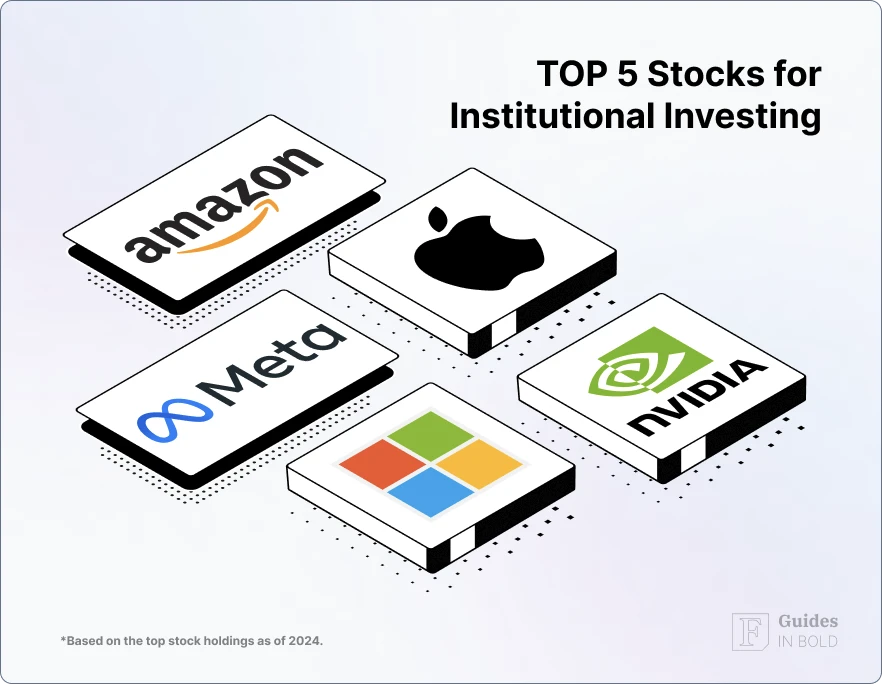
How do institutional investors affect the stock market?
The question of the impact of institutional investing on the stock market is perhaps wrong, especially if we consider the scale of it.
If we consider that the vast majority of stock transactions (more than 80%) come from institutional investing, the stock market is defined by institutional investing.
The big players form the dominant force behind supply and demand and hold the biggest positions in the market. In fact, whole companies rise and fall on the whims of the largest mutual funds and investment companies.
A study done in 2014 shows the decisive role of institutional investors in deepening the effects of the previous great recession. Additionally, as evident by the power and controversy of Institutional Shareholder Services (ISS), a proxy advisory firm that commands nearly half of all shareholder voting advisory market, institutional investors have spearheaded environmental, social, and governance (ESG) values investing, which has shaped today’s market, especially when it comes to energy and technology sectors.
Without a doubt, institutional investing is a dominant force in the stock market. Furthermore, it shapes the market environment with its transactions, but also management policies, extra financial interests, and sometimes even controversial precedents, such as the infamous 2021 Gamestop (GME) short squeeze controversy we mentioned at the beginning.
Are institutional investors beating the market?
Now, that’s a question of several trillion dollars! So, do institutional investors beat the market?
We often hear about the success of skilled portfolio managers and the profitability of active stock management. After all, numerous millionaires earned their wealth by picking the right stock! And yes, they do exist, but they are a marginal, ever-shrinking minority.
“Every year, S&P Dow Jones Indices does a study on active versus passive management. [In 2019], they found that after ten years, 85% of large-cap funds underperformed the S&P 500, and after 15 years, nearly 92 percent are trailing the index.”
—Larry Swedroe, chief research officer for Buckingham Wealth Partners and author or co-author of 18 investment books
Swedroe, among other experts, posits that the market has changed in recent years and is much better at equalizing market value with intrinsic value. In other words, the market is much more efficient than a few decades ago, so picking out undervalued or overpriced stocks is much rarer and less reliable.
Furthermore, institutional investing is much more common than in the previous decades: for example, in 1940, the net purchases by institutional investors amounted to a total of $100 million, according to this study, which was almost negligible compared to retail investing. In the 1950s, institutional stock purchases amounted to about 10%. With the decades, the whales caught up, then overtook the primacy, ultimately becoming the dominant force on the market.
The S&P DJI annually releases the findings of their SPIVA research on the profitability of active stock management versus passive investing. It has consistently concluded that very few active managers outperform passive indices.
SPIVA research tells us that relatively few active managers can outperform passive managers over any given time period, either short-term or long-term. Even Warren Buffett, the great investor and one of the richest people on the planet, has advocated passive investing: making (and winning) a bet in 2007 that an ordinary S&P 500 index fund investing would outperform any hedge fund with management fees.
So, are institutional investors beating the market?
How many investors beat the S&P 500?
But the most successful ones do. If you find and successfully track the right one, so will you.
How to track institutional stock trading?
Some institutional investors are registered just like regular public companies and must file quarterly reports with the SEC, which are then made available to the general public.
SEC Form 13F
Form 13F is mandatory for all institutional managers with more than $100 million in AuM and must be filed within 45 days of the last day of the calendar quarter.
These reports aim to enhance the transparency of the largest institutional investors and provide the public with information such as a list of securities managed, including company names, the number of shares held, and the value of the stocks.
Other forms
The SEC requires additional reports, depending on the type of institutional investor and the given financial context:
- Form 13D: Similar to Form 13F, it is filed when a company reaches the threshold of 5% of company voting power and intends to influence the management or daily operations. It must be filed within ten days from the moment of acquiring more than 5% of voting shares, and it informs the public about the acquiring institution, the purpose of the transaction, and plans for the future;
- Form 13G: It is the version of Form 13D for companies that acquire more than 5% of voting power but do not plan to exert influence on company operations (e.g., passive investors);
- Form N-PORT: A monthly report that informs the SEC about the fund’s portfolio, including securities owned, exposure to risk, and the amount of liquidity;
- Form N-CEN: An annual report that provides census-like information about the fund’s operations, securities portfolio, and service providers;
- Form PF: This form is meant for private institutional investors with $150 million or more in AuM. It provides confidential data on assets, leverage, and risk. It is not disclosed to the general public but is a way for the SEC to monitor private institutional investors like hedge funds and private equity;
- Form ADV: Finally, this form is filed by financial advisors upon registration and requires annual updating (or if the filed information changes) and lists their operations, services offered, and regulatory disclosures.
Examples
In short, mutual funds and ETFs must regularly file annual, semi-annual, and quarterly reports detailing their holdings, financial performance, and fiscal statements. These can be found on EDGAR, the SEC’s official database available to the public, as well as on the official websites of these institutional investors.
On the other hand, some institutional investors, like hedge funds and private equity firms, are exempt from filing such reports because they are open only to accredited and institutional investors. They must still file periodic reports to the SEC, which are not publicly available.
Other institutional investors, like pension funds and endowments or foundations, frequently disclose some information. Still, regulatory requirements for these can vary from case to case, depending on the nature of these organizations.
Online tracking services and brokerage platforms
Although all the relevant information you can find is available on the EDGAR database, the repository is exhaustive and often difficult to navigate. Therefore, many investors decide to use online tracking services, brokerage platforms, and other types of trackers to get a filtered selection of the relevant trades.
Be the first to learn!
How to use institutional investing to inform your trade decisions?
As we said earlier, institutional investing has much more expertise and sophisticated tools than most retail investors could ever have. However, you can take a look at their own transactions and derive conclusions that can help you inform your own trading strategy.
- Analyze the SEC filings. Whether you manually go through regular filings or filter your findings through an online service or tracker, make sure to continuously monitor institutional investors of interest. Also, make sure to consider the time delay of their transactions. Try to think one step ahead – just like them;
- Check the dark pools for additional context. Although dark pools are much less transparent than regular exchanges, there is still some information available to the public, including that published by the Financial Industry Regulatory Authority (FINRA) on a weekly basis and from certain market data platforms like Bloomberg;
- Observe the sentiment towards different sectors. Institutional investors have sectors, industries, and even stocks that they favor above others. In fact, as we have shown, the favorite stocks between different whales are frequently the same. Also, check which sectors institutional investors are leaving and which they are entering, as a definite conclusion can often reveal an underlying trend;
- 4. Check for insider and large block trades. Although buying and selling in bulk is painful, big players sometimes have no choice but to do precisely that. Such signals are visible, and a keen observer can spot them on time. Furthermore, insider trading is also a telling sign, and if both insiders and institutional investors converge in opinion, you might consider following them.
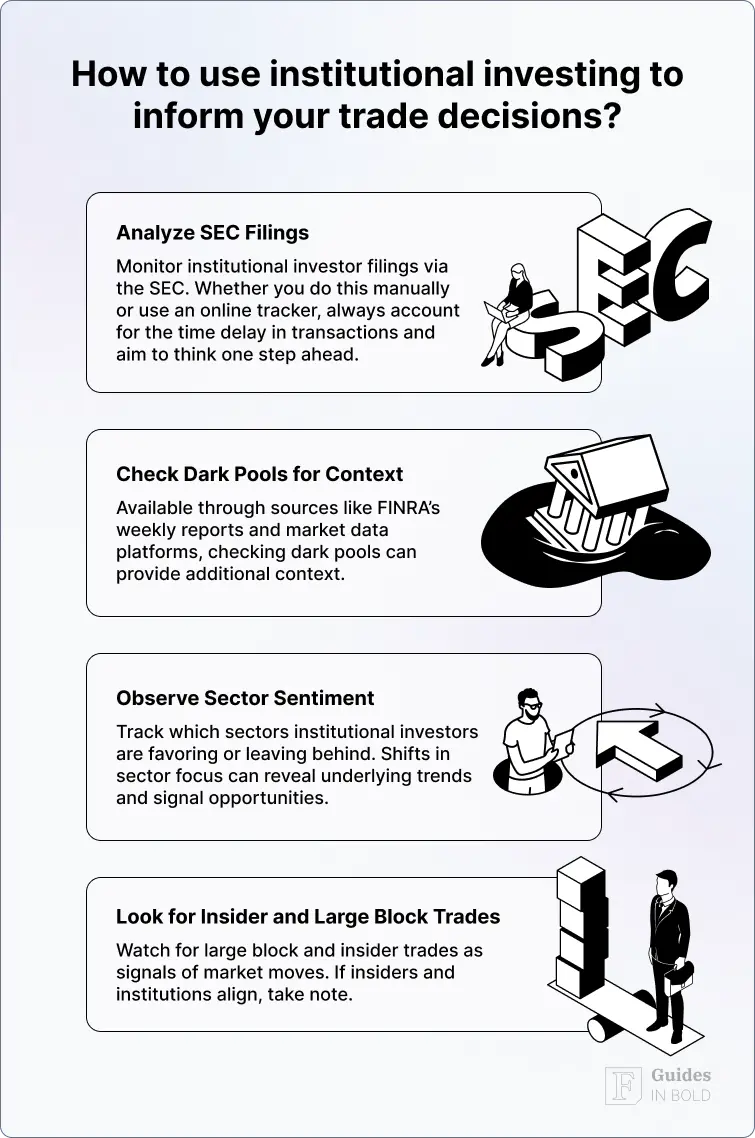
Which institutional investor to track?
Although we have explored this topic in detail here, we’ll touch upon the results of the inquiry here: the answer depends.
If you’re looking short-term, there are mutual and expertly managed funds that beat the market for a year or two. However, an actively managed fund has yet to beat the S&P 500 in the long run. But sticking with the market basically eliminates your chances of defeating it (if that is your goal).
Whatever choice you make, consider the following:
- Sector focus and versatility: Most institutional investors currently favor the technology sector, especially industries closely related to digital technologies and artificial intelligence. However, this was not always the case, as the currently lagging financial sector was the darling in previous sectors until it experienced a downturn. Keep an eye out for sector bias and whether you agree with the portfolio selection before you invest;
- Alignment with your investing strategy: Different institutional investors employ different approaches, including value investing, growth investing, and other long- and short-term strategies. Make sure your choice aligns with your investing style;
- Investment period: Some institutional investors embrace long-term strategies, while others are more inclined to engage in active and alternative investments or pursue high-frequency trading or industry-grade day trading. Again, make sure to synchronize your time horizon with that of the institution you wish to track;
- Consider previous performance: As we said, many hedge funds and similar institutional investors achieve stellar success before they experience miserable failure. Make sure to check how long the investor has been actively managed and compare its current yields with its previous performance.
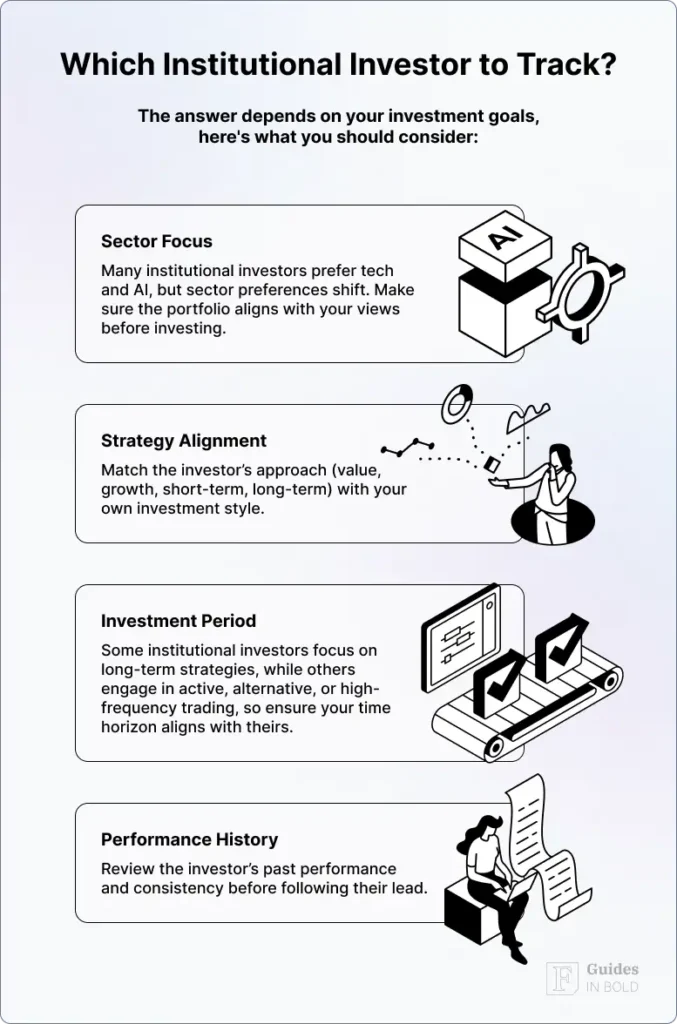
Tips and tricks for institutional investing
Okay, so a lot has been said in this guide, and it might be a bit too much to digest in one go. If you’re here just for tips and tricks, let’s get you a (very) boiled-down version of serviceable advice:
- Institutional investors rarely trade small-cap stocks. Beating them at their own game is like playing a game on nightmare difficulty. However, institutional investors have yet to encroach upon small-cap stocks. If you insist on attempting an active stock investing strategy, consider picking shares in smaller companies;
- Look for value. Fundamental analysis is crucial to the success of institutional investors. Make sure to apply it yourself and potentially discover undervalued stocks that you can benefit from in the long run;
- If you are serious about investing, always be on the lookout for relevant information. You can never get too informed when it comes to investing. Furthermore, there is no such thing as a lousy source with good advice. In fact, many have discredited the now-famous Redditors who initiated the Gamestop short squeeze, including the giant whales themselves. Therefore, always search for relevant information, even on forums;
- Trade fast. The sooner you act on a relevant institutional trade, the higher the potential profit. Keep in mind that others are also tracking institutional investors, and the word travels quickly through the fiber-optic cables of the internet. If you are confident in the integrity of your signal, act as soon as possible;
- Confirm your information with research. Never make a decision based on institutional transactions alone. Always double-check whether the move aligns with your strategy and do your own research to verify the benefits. Control your emotional urges, carefully manage risk, and avoid putting all your eggs in one basket.
Disclaimer: The content on this site should not be considered investment advice. Investing is speculative. When investing, your capital is at risk.
FAQs about institutional investing
What is an institutional investor?
An institutional investor is a company or organization that pools funds and invests that money on behalf of other people in various assets and financial instruments.
What is the difference between institutional investors vs. retail investors?
Institutional investors have more funds than retail investors. They trade in much larger volumes, often buying stock in bulk, a hundred or thousand times more than a retail investor would trade. Due to sheer scale, their transactions significantly influence the rest of the market.
What is an example of institutional investing?
A hedge fund that buys shares in a company on behalf of its clients is an example of institutional investing. The company earns an income from commissions and fees while the rest of any potential earnings are shared with the clients.
How to track institutional trading?
The public can access institutional trading reports on the SEC’s repository EDGAR. However, that database is vast and challenging, so it is better to use a tracking tool like Finbold Signals.
How to become an institutional investor?
To become an institutional investor, you need to register with the SEC and find clients who are willing to entrust you with their funds. Naturally, obtaining a degree in finance or sufficient investing experience is required, too.
How do institutional investors decide where to invest?
Institutional investing relies on a plethora of specialized tools, expert portfolio managers, and years of experience tracking the market and investing in the right company. Aided by a combination of advanced methodology, long-term perspective, and artificial intelligence tools, their investment choices tend to be more sophisticated than those of retail investors.
What are the institutional trading methods?
Some of the most common institutional trading methods include value investing, long-term strategy, fundamental and technical analysis, and mass-trading models.
How do institutional traders manipulate the market?
Institutional traders affect the market due to the vast scale of their trades. To circumvent this, they trade via dark pools, engage in high-frequency trading, and sometimes act based on insider information.
How do institutional traders make money?
Institutional traders usually make money from commissions and portfolio management fees, as well as a portion of eventual profits.
Who is the world's largest institutional investor?
BlackRock is the world’s largest institutional investor as of 2024.
Who are the Big Three institutional investors?
The big three institutional investors include BlackRock, the Vanguard Group, and State Street.
Do institutional investors move the market?
Institutional investing makes up over 80% of the total stock market transactions. In other words, their influence does move the market.
Where can I find institutional stock trading information?
Not all institutional investors are public companies, but most are and thus have to file their financial reports with the SEC regularly. All these reports are available on the EDGAR online repository.
